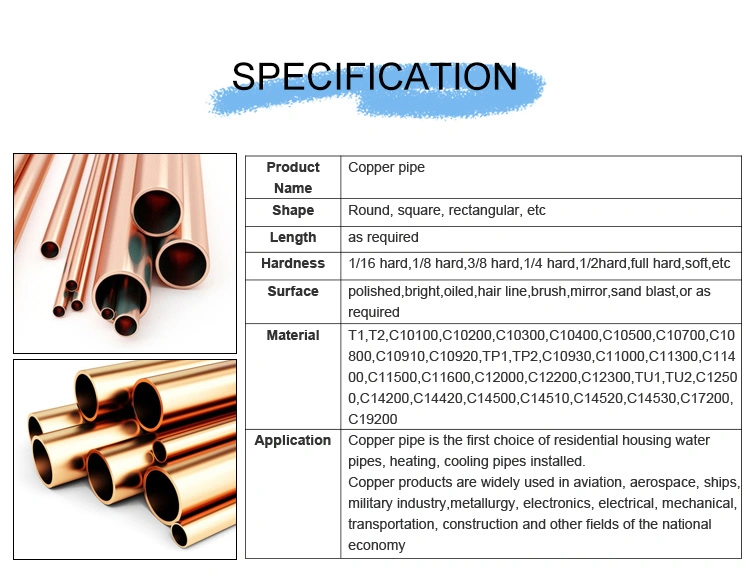Basic Info.
Certification
CE, ISO, RoHS
Standard
ASTM B88, ASTM B837, ASTM B306, ASTM B883, ASTM B819
Grade
H96
State
Hard
Customized
Customized
Color
Red
Transport Package
Standard Seaworthy Export Packing
Specification
as your demands
Origin
China
HS Code
7411101900
Production Capacity
2500 Tons/Year
Product Description
 Copper tubing is commonly found in use for heating systems and in hot and cold water transportation. Copper used to be really popular for hot and cold water supply, but it is slowly being replaced by PEX. You can also find copper pipes as a refrigerant line in HVAC systems.
Copper tubing is commonly found in use for heating systems and in hot and cold water transportation. Copper used to be really popular for hot and cold water supply, but it is slowly being replaced by PEX. You can also find copper pipes as a refrigerant line in HVAC systems.  Copper is a soft, malleable and malleable metal with very high thermal and electrical conductivity. The newly exposed pure copper surface is pinkish orange. Copper is used as a conductor of heat and electricity, a building material, and a constituent of various metal alloys, such as cupronickel for making marine hardware and coins, and constantan for strain gauges and thermocouples for temperature measurement.
Copper is a soft, malleable and malleable metal with very high thermal and electrical conductivity. The newly exposed pure copper surface is pinkish orange. Copper is used as a conductor of heat and electricity, a building material, and a constituent of various metal alloys, such as cupronickel for making marine hardware and coins, and constantan for strain gauges and thermocouples for temperature measurement.  copper are used as a durable, corrosion-resistant and weather-resistant building material. Roofs, flashings, gutters, downspouts, domes, spires, vaults and doors have been made of copper for hundreds or thousands of years. Architectural uses of copper have expanded in modern times to include interior and exterior wall cladding, architectural expansion joints, radio frequency shielding, and antimicrobials. As well as decorative interior products such as beautiful handrails, bathroom fixtures and countertops. Some other important benefits of copper as a building material include low thermal movement, light weight, lightning protection and recyclability
copper are used as a durable, corrosion-resistant and weather-resistant building material. Roofs, flashings, gutters, downspouts, domes, spires, vaults and doors have been made of copper for hundreds or thousands of years. Architectural uses of copper have expanded in modern times to include interior and exterior wall cladding, architectural expansion joints, radio frequency shielding, and antimicrobials. As well as decorative interior products such as beautiful handrails, bathroom fixtures and countertops. Some other important benefits of copper as a building material include low thermal movement, light weight, lightning protection and recyclabilityThe unique natural green lustre of metal has long been coveted by architects and designers. The final patina is a particularly durable layer that is highly resistant to atmospheric corrosion, thus protecting the underlying metal from further weathering. It can be a mixture of carbonate and sulfate compounds in varying amounts, depending on environmental conditions, such as sulfuric acid rain. Architectural copper and its alloys can also be "finished" to give a specific look, feel or color. Surface treatment includes mechanical surface treatment, chemical coloring and coating.
Copper has excellent brazing properties and can be welded; best results are obtained with gas metal arc welding.


